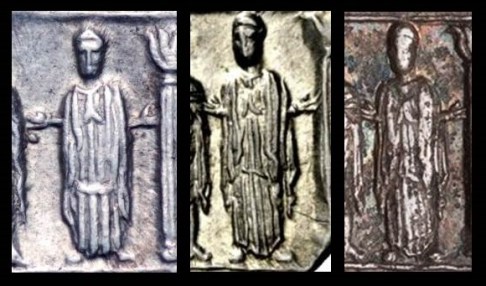All the coins of C. Egnatius Maxsumus (c. 75-76BC) have a personification of Libertas. Beside this representation above he also showed her riding in a biga accompanied by Victory and as a bust on the obverse of another coin. Those representations are pretty standard and like this one the identification as Libertas is made by the inclusion of a pileus, the hat given to freed slaves. Here’s the whole reverse. The pileus is above her in the architectural representation:
There’s lots to be curious about this representation. If as Crawford says this is the temple of Jupiter Libertas why are there two cult figures? Also, this is the first time a divinity is shown in their temple like this — a time that will become standard throughout the Roman empire for centuries. The die cutter has gone to a lot of trouble to show the details of these figures the radiate(?) crown of Jupiter, the height of his staff, the different dress of the two figures, and their respective gestures. The gesture of Libertas is an Orans type usually associated with priestesses in both Greek and Roman iconography. Here’s a Vestal from the early second Century AD (said to be from the Roman Forum now in the Terme Museum):

But given that the figure is just the same size and representation as Jupiter it must be a goddess and Libertas remains the best identification. Later, Pietas will be similarly represented on coins:
It rather understandable that Pietas could be personified through the action of prayer. It is harder to find a divinity thus represented. Unless we consider archaic cult figures. Perhaps most famous is Artemis of Ephesus with her out stretched arms:

But also used in depictions of Artemis Anaitis:
It is also know from some terracottas thought to represent Tanit:

Even with attributes in her hands this cult image of Athena from Abydos has a similar pose:

While I don’t put much stock in the idea that this specimen (or many other architectural coin types, with a few key exceptions) can be taken to be ‘accurate’ representations of buildings, it does seem to me the die cutter is going out of his way to represent particular cult statues here, perhaps ones of some antiquity or rendered in an archaizing fashion.
[A huge thanks to all my social media friends who shared their thoughts on this image with me!]




[…] Here’s an earlier post about (Jupiter) Libertas at Rome. […]
[…] awhile ago I blogged about the unusual cult image of libertas on RRC 391/2. I was remind of that post when I found this Etruscan painting. Note how the goddess is represented, very columnar but with […]
[…] (mine does). The connection is with my earlier contextualization of RRC 391/2 in these posts (earlier, more […]
[…] wrote a long blog post on the orans figure of Libertas on RRC 391/2 almost ten years […]